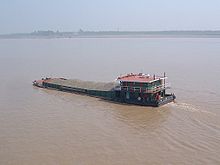Barge: Difference between revisions
No edit summary |
|||
| Line 70: | Line 70: | ||
* [http://www.marinelink.com/Story/search.aspx?SearchString=barge&Dates=20060524 Barges News] |
* [http://www.marinelink.com/Story/search.aspx?SearchString=barge&Dates=20060524 Barges News] |
||
*[http://www.1911encyclopedia.org/Barge 1911 Britannica article] |
*[http://www.1911encyclopedia.org/Barge 1911 Britannica article] |
||
==Museum ships== |
|||
[http://www.waterfrontmuseum.org/ Barge Lehigh Valley 79 at the Waterfront Museum], [[Brooklyn]], NY, USA |
|||
{{ModernMerchantShipTypes}} |
{{ModernMerchantShipTypes}} |
||
Revision as of 18:04, 23 February 2008




A barge is a flat-bottomed boat, built mainly for river and canal transport of heavy goods. Most barges are not self-propelled and need to be moved by tugboats towing or towboats pushing them. Barges on canals (towed by draft animals on an adjacent towpath) contended with the railway in the early industrial revolution but were outcompeted in the carriage of high value items due to the higher speed, falling costs, and route flexibility of rail transport.
Modern use
Barges are still used today for low value bulk items, as the cost of hauling goods by barge is very low. Barges are also used for very heavy or bulky items; a typical barge measures 195 feet by 35 feet (59.4 meters by 10.6 meters), and can carry up to 1500 tons of cargo. As an example, on June 26, 2006, a 565 ton catalytic cracking unit reactor was shipped from the Tulsa Port of Catoosa in Oklahoma to a refinery in Pascagoula, Mississippi. While such parts are normally shipped in sections and assembled onsite, shipping the assembled unit reduces costs and does not rely on availability of construction labor at the site (which in this case is still recovering from Hurricane Katrina). Such a large item is not practical to transport over land for any significant distance and will need to be transported only 40 miles overland to get from the port to the refinery.
Self propelled barges may be used as such when traveling downstream or upstream in placid waters and operated as an unpowered barge with the assistance of a tugboat when traveling upstream in faster waters. Canal barges are usually made for the particular canal in which they will operate.
Types of barges
- Barracks barge (living quarters)
- Car float
- Company barge
- Dutch barge
- Dry bulk cargo barge (coal, rock, grain, etc.)
- Hopper barge
- Jackup barge
- Lighter, Dumb steel lighter
- Liquid cargo barge (fresh water, finished petroleum products)
- Log Barge, for transport of raw logs for processing
- Oil barge, Dumb steel oil barge
- Pleasure barge- providing a floating bedroom, dance floor, or viewing platform
- Railcar barge (with tracks and using special loading/offloading facilities such as a barge slip)
- Royal barge (ceremonial) (e.g. Thailand's Royal Barges)
- Row barge
- Sand barge
- Severn trow
- Tom Pudding
- Vehicular barge, often used to transport vehicles to natural shorelines such as beaches
- Ware barge
- West country barge
On the Great British canal system, the term barge is used to describe a boat wider than a narrowboat.
The people who move barges are often known as lightermen.
In the U.S. deckhands perform the labor and are supervised by a leadman and or the mate. The Captain and Pilot steer the towboat. The towboat pushes one or more barges that are held together with rigging and is called collectively the tow. The crew live aboard the towboat as it travels along the inland river system and or the intracoastal waterways. These towboats travel between ports and are also called line haul boats.
Poles are used on barges to fend off the barge as it nears other vessels or a wharf, often called pike poles, and on shallow canals for example in the UK long punt poles are used to manoeuvre or propel the barge.
Etymology
Barge is attested from 1300, from Old French barge, from Vulgar Latin barga. The word originally could refer to any small boat, the modern meaning arose around 1480. Bark "small ship" is attested from 1420, from Old French barque, from Vulgar Latin barca (400 AD). The more precise meaning "three-masted ship" arose in the 17th century, and often takes the French spelling for disambiguation.
Both are probably derived from a Latin *barica, from Greek baris "Egyptian boat", ultimately from m Coptic bari "small boat."
By extension, the term "embark" literally means to board the kind of boat called a "barque".
The long poles used to manouver or propel a barge have given rise to the saying, "I wouldn't touch that (subject/thing) with a barge pole." This is a variation on the phrase "I wouldn't touch that with a (insert length) pole." It appears that the association with barge poles came after the phrase was in use. Modern usage uses a ten foot pole, but the earliest instances in print involve a forty foot pole[1], which is improbably long for operating a barge.
See also
- Narrowboat
- Thames sailing barge
- Theodore Tugboat
- Mobro 4000
- Barge carrier
- Barges in TUGS
- Canal boat Ross Barlow
External links
Museum ships
Barge Lehigh Valley 79 at the Waterfront Museum, Brooklyn, NY, USA
